Improvement in Limit of Detection of Enzymatic Biogas Sensor Utilizing Chromatography Paper for Breath Analysis
Abstract
:1. Introduction
2. Theory and Experimental Method
2.1. Basic Principle of Limit of Detection
2.2. Ethanol Sensing Principle
2.3. Fabrication of Ethanol Biogas Sensor
2.4. Investigation of the Conditions for Reducing Background Current
2.5. Sensor Testing with Ethanol Gas for Analysis of Limit of Detection
3. Results and Discussion
3.1. Reduction of Background Current for Biogas Sensor
3.1.1. Condition for Reducing Background Current
3.1.2. Trade-Off between Different Parameters
3.2. Evaluation of Limit of Detection with Different Ethanol Biogas Sensors
4. Conclusions
Acknowledgments
Author Contributions
Conflicts of Interest
References
- Noncommunicable Diseases Prematurely Take 16 Million Lives Annually, Annually, WHO Urges More Action. Available online: http://www.who.int/mediacentre/news/releases/2015/noncommunicable-diseases/en/ (accessed on 19 September 2017).
- John, A.S.; Price, C.P. Existing and Emerging Technologies for Point-of-Care Testing. Clin. Biochem. Rev. 2014, 35, 155–167. [Google Scholar]
- Khalil, H.; Halls, H.; Chambers, H.; Walker, J.; Shephard, M.D.S. Managing chronic diseases in rural aged care facilities using point-of-care testing systems. Rural Remote Health 2013, 13, 2597. [Google Scholar] [PubMed]
- Buszewski, B.; Kesy, M.; Ligor, T.; Amann, A. Human exhaled air analytics: Biomarkers of diseases. Biomed. Chromatogr. 2007, 21, 553–566. [Google Scholar] [CrossRef] [PubMed]
- Wang, C.; Sahay, P. Breath Analysis Using Laser Spectroscopic Techniques: Breath Biomarkers, Spectral Fingerprints, and Detection Limits. Sensors 2009, 9, 8230–8262. [Google Scholar] [CrossRef] [PubMed]
- Deng, C.; Zhang, J.; Yu, X.; Zhang, W.; Zhang, X. Determination of acetone in human breath by gas chromatography-mass spectrometry and solid-phase microextraction with on-fiber derivatization. J. Chromatogr. B 2004, 810, 269–275. [Google Scholar] [CrossRef]
- Nasution, T.I.; Nainggolan, I.; Hutagalung, S.D.; Ahmad, K.R.; Ahmad, Z.A. The sensing mechanism and detection of low concentration acetone using chitosan-based sensors. Sens. Actuators B 2013, 177, 522–528. [Google Scholar] [CrossRef]
- Cao, W.; Duan, Y. Breath Analysis: Potential for Clinical Diagnosis and Exposure Assessment. Clin. Chem. 2006, 52, 800–811. [Google Scholar] [CrossRef] [PubMed]
- Grote, C.; Pawliszyn, J. Solid-Phase Microextraction for the Analysis of Human Breath. Anal. Chem. 1997, 69, 587–596. [Google Scholar] [CrossRef] [PubMed]
- Lord, H.; Yu, Y.; Segal, A.; Pawliszyn, J. Breath Analysis and Monitoring by Membrane Extraction with Sorbent Interface. Anal. Chem. 2002, 74, 5650–5657. [Google Scholar] [CrossRef] [PubMed]
- Righettoni, M.; Tricoli, A.; Pratsinis, S.E. Si:WO3 Sensors for Highly Selective Detection of Acetone for Easy Diagnosis of Diabetes by Breath Analysis. Anal. Chem. 2010, 82, 3581–3587. [Google Scholar] [CrossRef] [PubMed]
- Rezlescu, N.; Iftimie, N.; Rezlescu, E.; Doroftei, C.; Popa, P.D. Semiconducting gas sensor for acetone based on the fine grained nickel ferrite. Sens. Actuators B 2006, 114, 427–432. [Google Scholar] [CrossRef]
- Yamazoe, N.; Sakai, G.; Shimanoe, K. Oxide semiconductor gas sensors. Catal. Surv. Asia 2003, 7, 63–75. [Google Scholar] [CrossRef]
- Mitsubayashi, K.; Matsunaga, H.; Nishio, G.; Toda, S.; Nakanishi, Y. Bioelectronic sniffers for ethanol and acetaldehyde in breath air after drinking. Biosens. Bioelectron. 2005, 20, 1573–1579. [Google Scholar] [CrossRef] [PubMed]
- Sathiyamoorthi, R.; Chandrasekaran, R.; Mathanmohan, T.; Muralidharan, B.; Vasudevan, T. Study of electrochemical based gas sensors for fluorine and chlorine. Sens. Actuators B 2004, 99, 336–339. [Google Scholar] [CrossRef]
- Fergus, J.W. A review of electrolyte and electrode materials for high temperature electrochemical CO2 and SO2 gas sensors. Sens. Actuators B 2008, 134, 1034–1041. [Google Scholar] [CrossRef]
- Yunusa, Z.; Hamidon, M.N.; Kaiser, A.; Awang, Z. Gas Sensors: A Review. Sens. Transducers 2014, 168, 61–75. [Google Scholar]
- Azad, A.M.; Akbar, S.A.; Mhaisalkar, S.G.; Birkefeld, L.D.; Goto, K.S. Solid-State Gas Sensors: A Review. Electrochem. Soc. 1992, 139, 3690–3704. [Google Scholar] [CrossRef]
- Gessei, T.; Sato, H.; Kazawa, E.; Kudo, H.; Saito, H.; Mitsubayashi, K. Bio-sniffers for ethanol and acetaldehyde using carbon and Ag/AgCl coated electrodes. Microchim. Acta 2009, 165, 179–186. [Google Scholar] [CrossRef]
- Kuretake, T.; Kawahara, S.; Motooka, M.; Uno, S. An Electrochemical Gas Biosensor Based on Enzymes Immobilized on Chromatography Paper for Ethanol Vapor Detection. Sensors 2017, 17, 281. [Google Scholar] [CrossRef] [PubMed]
- Kawahara, S.; Fuchigami, Y.; Shimokawa, S.; Nakamura, Y.; Kuretake, T.; Kamahori, M.; Uno, S. Portable Electrochemical Gas Sensing System with a Paper-Based Enzyme Electrode. Telkomnika 2017, 15, 895–902. [Google Scholar]
- Winefordner, J.D.; Long, G.L. Limit of Detection a Closer Look at the IUPAC Definition. Anal. Chem. 1983, 55, 713–724. [Google Scholar]
- Everritt, B.S.; Skrondal, A. The Cambridge Dictionary of Statistics, 4th ed.; Hesketh, S.R., Landau, S., Meteyard, H., Eds.; Cambridge University Press: New York, NY, USA, 2010; p. 89. ISBN 978-0-521-76699-9. [Google Scholar]
- Bland, M.; Altman, D.G. Statistics Notes Measurement error proportional to the mean. BMJ 1996, 313, 106. [Google Scholar] [CrossRef] [PubMed]
- Rama, E.C.; Biscay, J.; Garcia, M.B.G.; Reviejo, A.J.; Carrazon, J.M.P.; Garcia, A.C. Comparative study of different alcohol sensors based on Screen-Printed Carbon Electrodes. Anal. Chim. Acta 2012, 728, 69–76. [Google Scholar] [CrossRef] [PubMed]
- Azevedo, A.M.; Prazeres, D.M.F.; Cabral, J.M.S.; Luis, P.F. Ethanol biosensors based on alcohol oxidase. Biosens. Bioelectron. 2005, 21, 235–247. [Google Scholar] [CrossRef] [PubMed]
- Bard, A.J.; Faulkner, L.R. Electrochemical Methods Fundamentals and Applications, 2nd ed.; David, H., Elizabeth, S., Charity, R., Eugene, A., Eds.; John Wiley & Sons, Inc.: New York, NY, USA, 2001; pp. 87–88, 163, 808. ISBN 978-0-471-04372-0. [Google Scholar]
- Williams, A.K.; Hupp, J.H. Sol-Gel-Encapsulated Alcohol Dehydrogenase as a Versatile, Environmentally Stabilized Sensor for Alcohols and Aldehydes. Am. Chem. Soc. 1998, 120, 4366–4371. [Google Scholar] [CrossRef]
- Wang, H.S.; Pan, Q.X.; Wang, G.X. A Biosensor Based on Immobilization of Horseradish Peroxidase in Chitosan Matrix Cross-linked with Glyoxal for Amperometric Determination of Hydrogen Peroxide. Sensors 2005, 5, 266–276. [Google Scholar] [CrossRef]
- Creanga, C.; Serban, S.; Pittoson, R.W.; Murri, N.E. “No Calibration” Type Sensor in Routine Amperometric Bio-sensing—An Example of a Disposable Hydrogen Peroxide Biosensor. In Biosensors—Emerging Materials and Applications; Intech: London, UK, 2011; pp. 141–152. [Google Scholar]
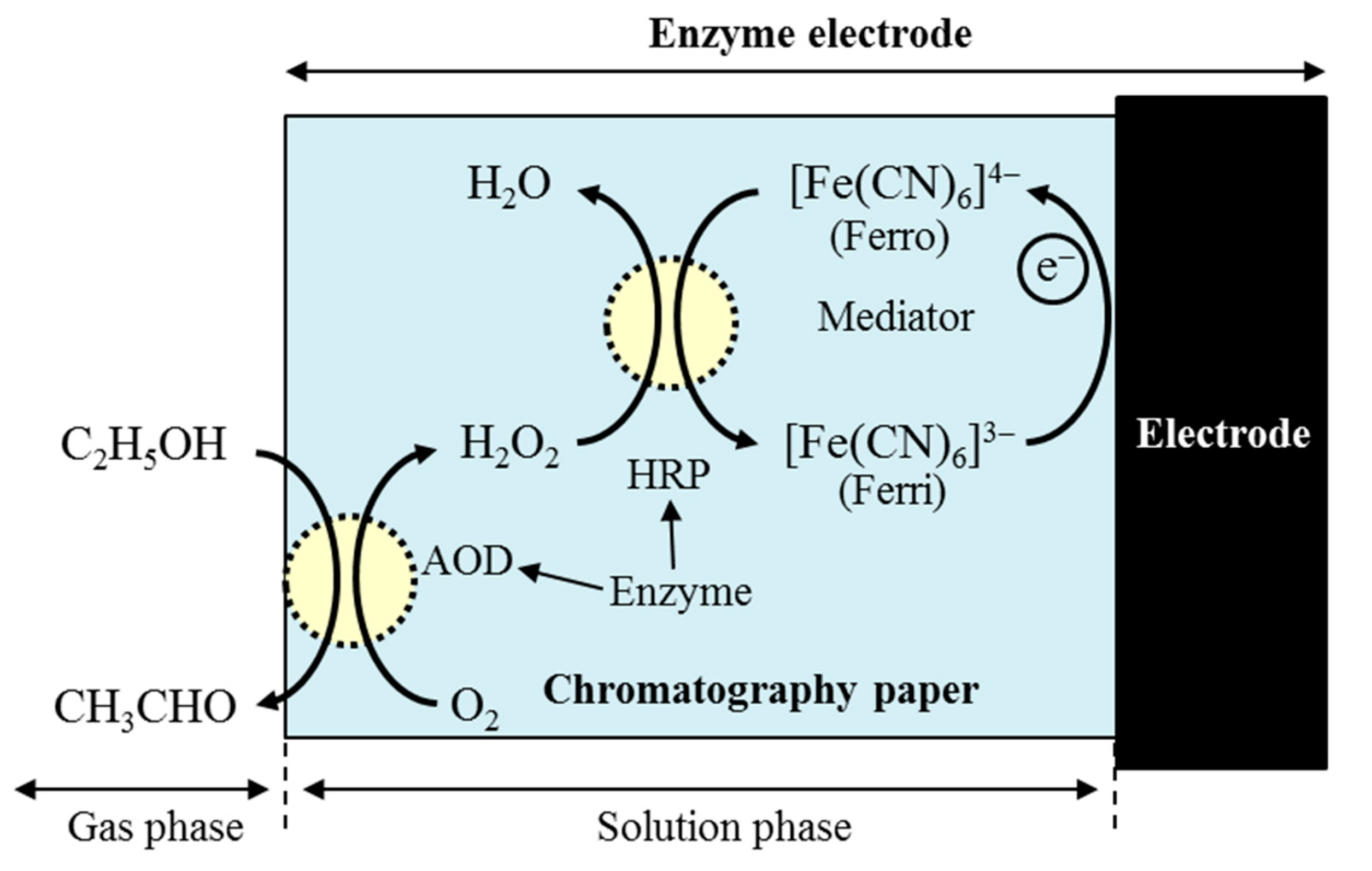
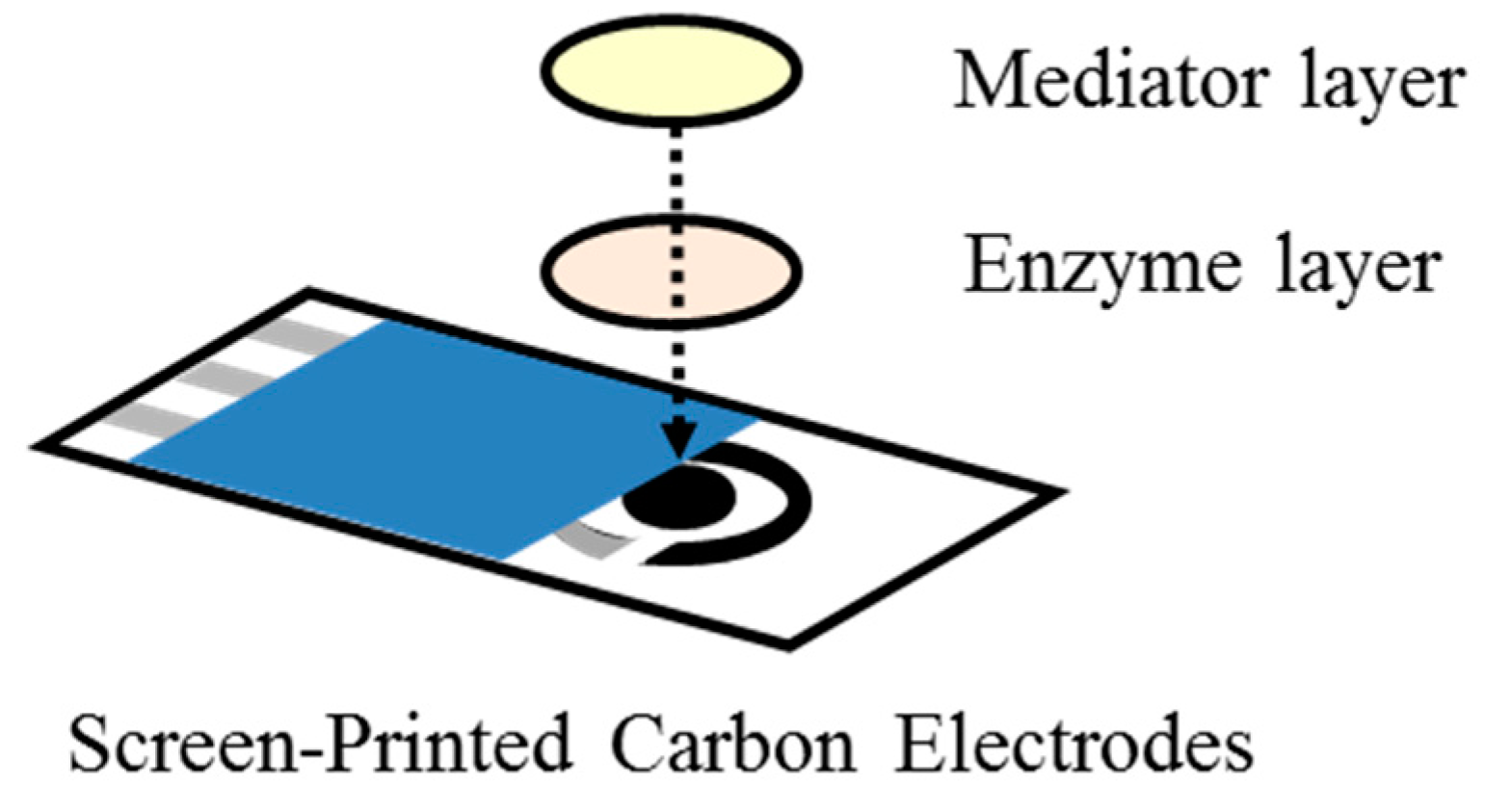
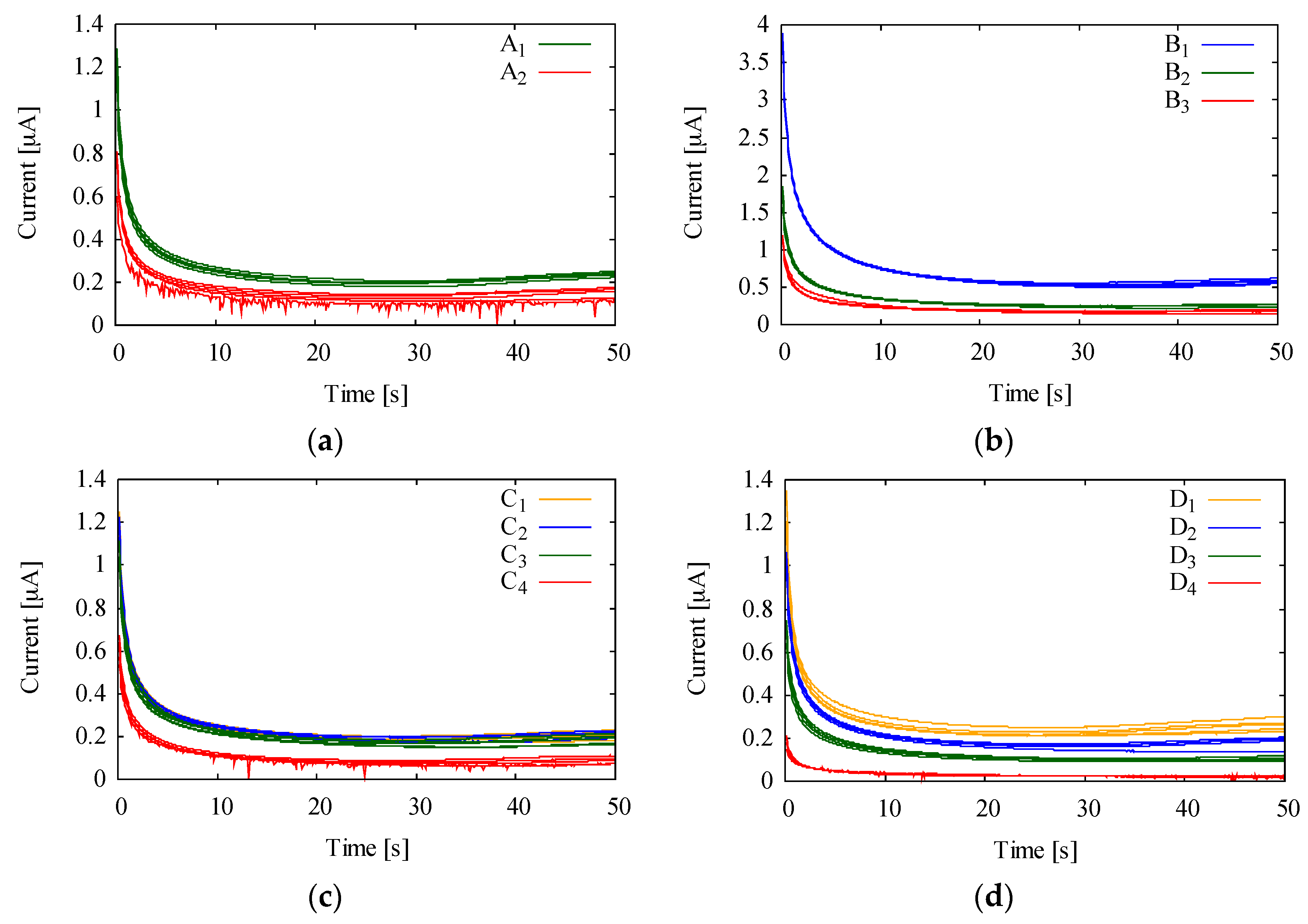
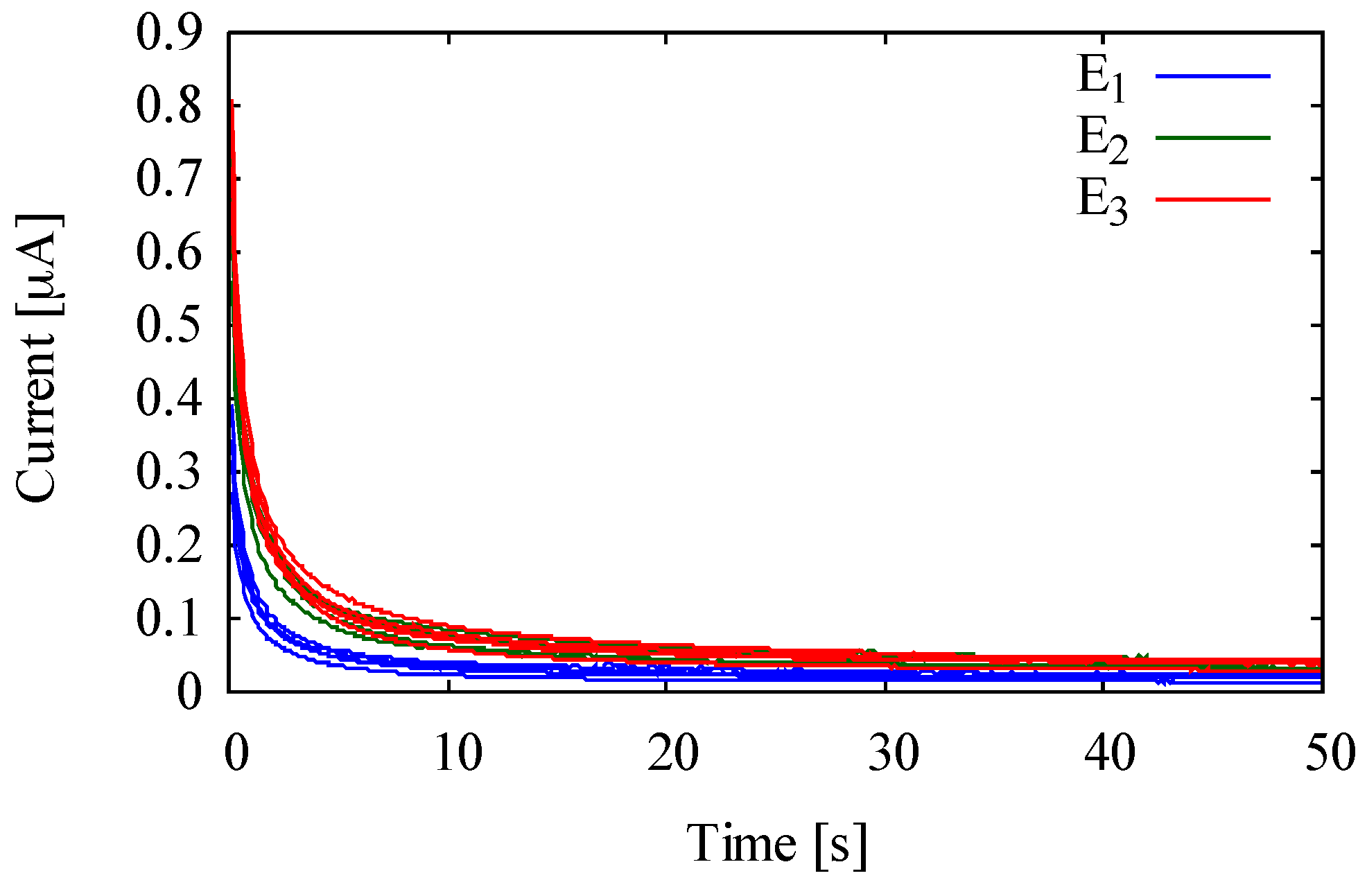
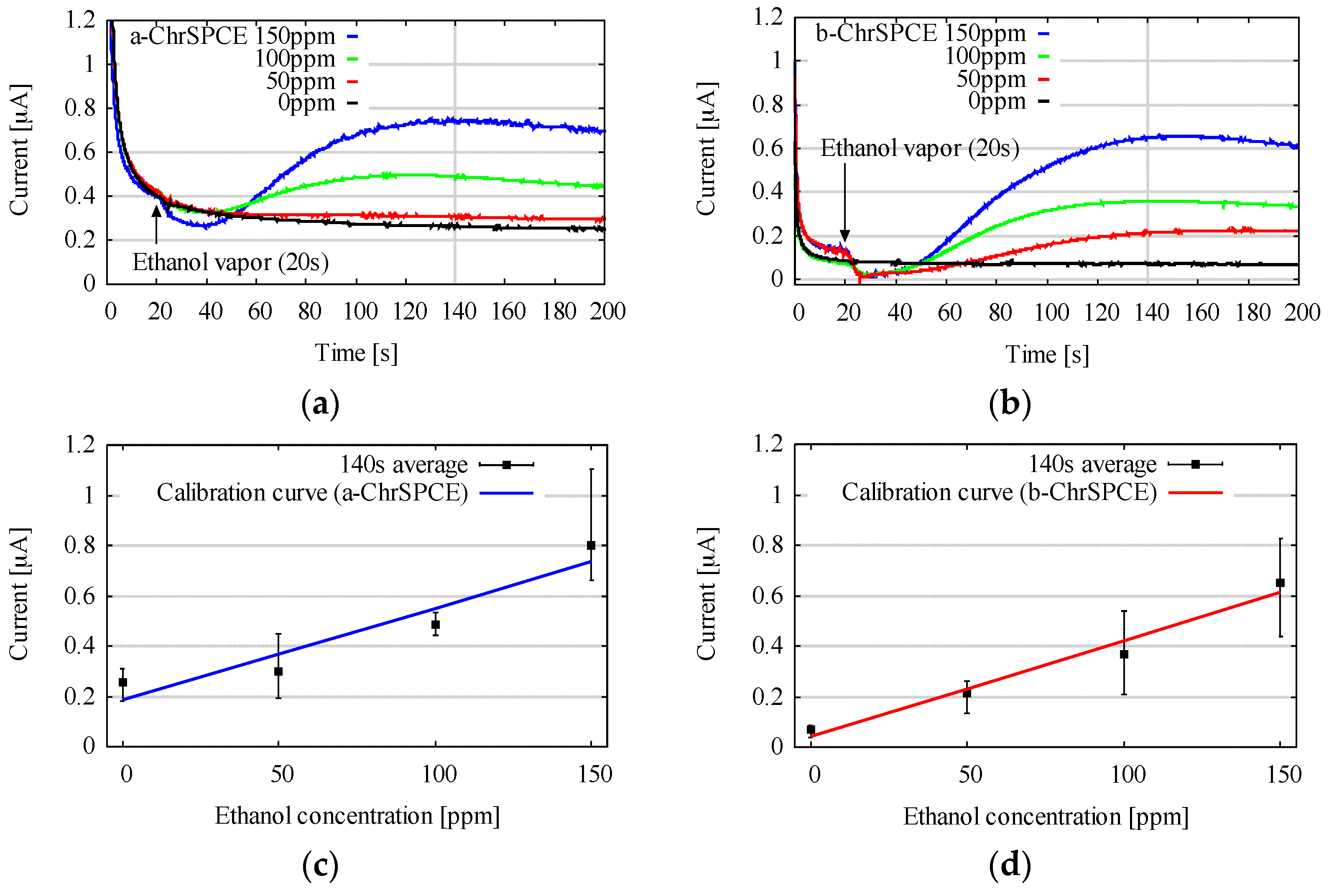
| Ferro Solution Sample | N2 Bubbling | Storage Temperature (°C) | Storage Time (h) | Ferro Concentration (mM) |
|---|---|---|---|---|
| A1 | — | 4 | 12 | 100 |
| A2 | ○ | 4 | 12 | 100 |
| B1 | — | 24 | 12 | 100 |
| B2 | — | 12 | 12 | 100 |
| B3 | — | 4 | 12 | 100 |
| C1 | — | 4 | 12 | 100 |
| C2 | — | 4 | 9 | 100 |
| C3 | — | 4 | 6 | 100 |
| C4 | — | 4 | 3 | 100 |
| D1 | — | 4 | 12 | 100 |
| D2 | — | 4 | 12 | 60 |
| D3 | — | 4 | 12 | 30 |
| D4 | — | 4 | 12 | 3 |
| Mediator Layer Sample | N2 Bubbling | Drying Temperature (°C) | Drying Time (min) | Ferro Concentration (mM) |
|---|---|---|---|---|
| E1 | ○ | 40 | 20 | 3 |
| E2 | ○ | 24 | 120 | 3 |
| E3 | ○ | 4 | 390 | 3 |
| ChrSPCE | ABGC (uA) | SB (uA) | M (uA/ppm) | CL (ppm) |
|---|---|---|---|---|
| a-ChrSPCE | 0.25 | 0.048 | 3.7 × 10-3 | 40.000 |
| b-ChrSPCE | 0.071 | 0.019 | 3.8 × 10-3 | 20.000 |
© 2018 by the authors. Licensee MDPI, Basel, Switzerland. This article is an open access article distributed under the terms and conditions of the Creative Commons Attribution (CC BY) license (http://creativecommons.org/licenses/by/4.0/).
Share and Cite
Motooka, M.; Uno, S. Improvement in Limit of Detection of Enzymatic Biogas Sensor Utilizing Chromatography Paper for Breath Analysis. Sensors 2018, 18, 440. https://doi.org/10.3390/s18020440
Motooka M, Uno S. Improvement in Limit of Detection of Enzymatic Biogas Sensor Utilizing Chromatography Paper for Breath Analysis. Sensors. 2018; 18(2):440. https://doi.org/10.3390/s18020440
Chicago/Turabian StyleMotooka, Masanobu, and Shigeyasu Uno. 2018. "Improvement in Limit of Detection of Enzymatic Biogas Sensor Utilizing Chromatography Paper for Breath Analysis" Sensors 18, no. 2: 440. https://doi.org/10.3390/s18020440




